MINISO LAND on Shanghai Nanjing Road opens up a new chapter for MINISO‘s brand positioning
During the National Day holiday last month, MINISO opened MINISO LAND, its first flagship global store, on Shanghai’s bustling Nanjing Road. This “IP theme park-style” retail space brings together globally loved IPs like Harry Potter, Sanrio, Disney, and Chiikawa, offering an immersive, narrative-driven environment with interactive features that elevate shopping into a journey of exploration and discovery. Less than a month after its soft launch, MINISO LAND has become a popular new landmark on Nanjing Road, drawing crowds of visitors and shoppers and achieving first-month sales in the tens of millions of yuan.


Spanning nearly 2,000 square meters across three floors on Nanjing Road Pedestrian Street, MINISO LAND features themed sections such as cute pets, aromatherapy, and blind boxes. Each area is carefully designed to reflect the unique characteristics of the products, creating a highly engaging experience for fans of these beloved IPs. Image: WeChat Account @上海圈子 @上海黄浦
MINISO LAND represents a major milestone in MINISO’s global brand strategy. In February last year, celebrating its tenth anniversary, MINISO announced a new global development strategy, positioning itself as a “global IP co-branded concept store.” As the world’s first immersive IP co-branded flagship, MINISO LAND marks the beginning of this fresh brand direction.
However, MINISO’s aggressive expansion through IP collaborations does carry some risks. Frequent partnerships have driven up licensing costs significantly. According to MINISO’s 2024 interim report, MINISO's 2024 interim report shows that licensing expenses increased 24.2%, consistent with revenue growth. As these costs continue to grow they are likely to impact profit margins. Since IP collaborations rely on strong fan engagement and emotional appeal, there is a risk that MINISO’s competitiveness may wane as contracts expire or licensing fees increase, potentially leading to higher prices for consumers.
A concise yet holistic summary of March 2025’s key marketing developments in China, highlighting valuable insights and their implications for brands.
Instead of chasing scale through aggressive franchising or racing to the bottom with price wars, Honeymoon and Ah-Ma Handmade are playing the long game: building brands rooted in culture, craftsmanship, and emotional connection
Luxury brands such as Burberry, Gucci, and Armani are selling heavily-reduced products at bulk warehouse Sam's Club - what does it mean for the brands?
Longchamp grew 20% last year while other luxury brands struggled. It did so by building its brand around its products, and by building immersive, seasonal experiences
POPMART's Labubu's popup in London's Harrod's is symbolic of increasingly global Chinese brands, and the plenty of lessons that come from them
China's Special Action Plan for Boosting Consumption is a positive for foreign brands in China, but there remain some challenges
Jack Ma launched New Retail with a roar in 2016 starting a scramble for the New Retail crown on both sides of the Pacific. The buzzword has since fizzled out and Alibaba has divested in much of its bricks & mortar retail properties, but the need to rethink retail is more important than ever. Here's why...
Despite being winter, Naimi's novel fried chicken-looking ice creams are flying out of the chiller. Their success provides many valuable lessons for brands selling in China
Xianyu's foray into physical retail illustrates five key lessons for retailers - both online and office - in how to differentiate and engage your target audience
A concise yet holistic summary of January 2025’s key marketing developments in China, highlighting valuable insights and their implications for brands.
Conversations are likely to be a little different for many young Chinese returning home for their Chinese New Year holiday
A Harper’s Bazaar campaign featuring hotpot CEOs is a testament to the power of blending fashion, culture, and business leadership. It not only redefines the role of CEOs in branding but also highlights broader trends in cultural revival, emotional connection, and experiential marketing.
AI has become an integrated tool for marketing in China 2025, making marketing easier at a surface level, but harder than it has ever been before. How do brands utilise AI to stand out?
A concise summary of last month's key marketing developments in China, highlighting valuable insights and their implications for brands.
MINISO has launched MINISO LAND, attracting massive crowds. Its first global “IP theme park-style” flagship blends globally- known IPs into an immersive shopping experience.
Social media feeds increasing filled with “rough life” posts, alongside the popularity of more authentic retail spaces are just two examples of how Chinese consumers are seeking more real, less polished marketing
China is experiencing a shift—or even a dilemma—in its bricks-and-mortar retail landscape. While high-end malls are seeing declines, non-standard commercial spaces are on the rise. Among these, Beijing’s THE BOX Youth Energy Center is redefining the offline retail experience by tapping into the spending power of the younger generation.
From in-house exhibitions to various brand collaborations, Shanghai Mental Health Center at 600 Wanping South Road is tapping into mental health concerns, helping to reduce stigma around mental health.
China's consumer landscape is increasingly divergent. Lower-tier cities are rebounding faster and showing greater resilience than first- and second-tier cities. While large catering businesses struggle, smaller restaurants thrive. How can brands understand these diverging trends and their implications? Read on to find out more.
The runaway growth of China's collectable toy market hasn't just stemmed from the toys themselves, but the ritual and occasion of the purchase journey - Jellycat's pop up cafe is case in point
Jellycat CAFÉ has taken Shanghai by storm with its limited-time pop-up. Exclusive plush toys and immersive packaging performances highlight Jellycat's unique blend of emotional value and playful creativity.
Beijing's total package for stimulus this year may be its largest yet in nominal terms, but how will it impact the all-important consumption segment?
Zara's pop up in Shanghai's trendy Anfu Lu provides plenty of lessons on marketing and retail for brands in China
Zara's Anfu Lu pop-up store in Shanghai's former French concession is being reinvented every week; here are photos of the first two iterations
In recent years, Shanghai's low-altitude economy has been rapidly commercializing, driven by successful developments in composite materials, a strong talent pool, and an expanding range of application scenarios presenting opportunities for travellers and brands alike.
Luxury consumer behaviour in China is returning to pre-pandemic traits.
Academic/Science bars are trending in cities like Beijing and Shanghai, offering a mix of intellectual talks and social relaxation in a laid-back, tipsy atmosphere.
Wukong is a huge deal in China, not just being the first AAA game and record sales and players, but for its wider impacts on consumer behaviour and branding opportunities
Founded in 2019, Tiaohai Village (跳海酒馆) is a community-driven pub brand. Despite having around 30 locations nationwide, it's said to have achieved over ¥100 million ($14m) in revenue in 2023, together with over 200 highly active online alcohol communities. Check it out to learn about what sets Tiaohai apart from other pubs and how it truly connects with Chinese young people emotionally.
Pangdonglai is rewriting the rules of retail in China, but not through a shiny new tech-based model






























